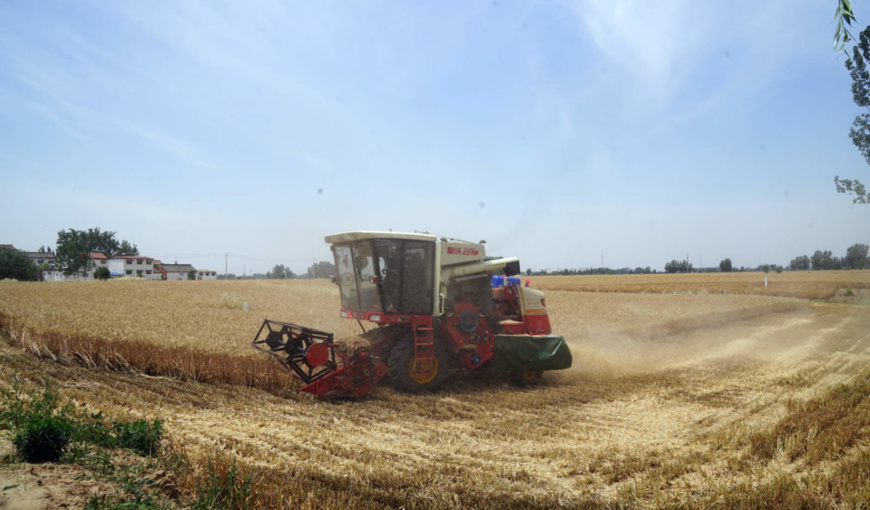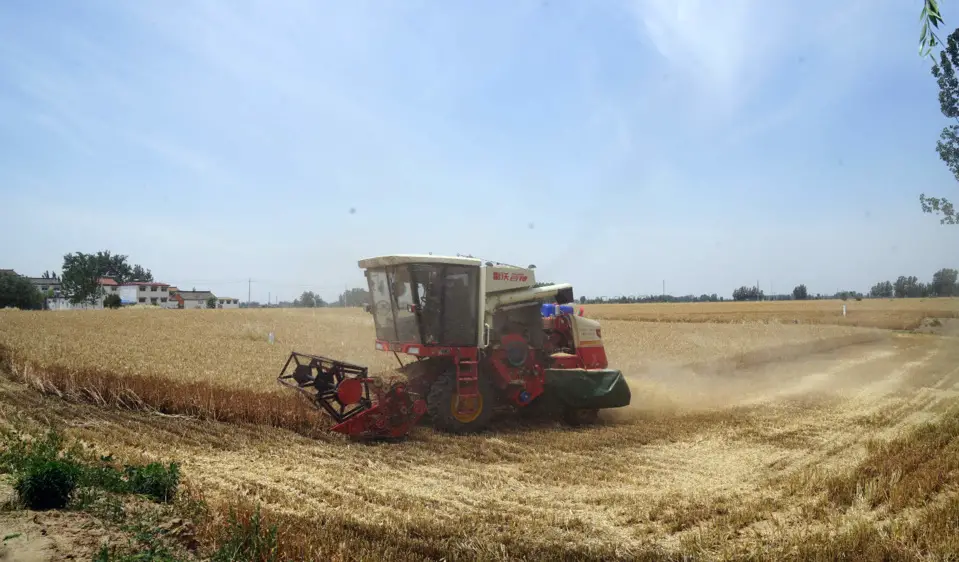By Wu Qiuyu, Qiu Chaoyi, People’s Daily

A harvesting machine works in a field in Xihua county, Zhoukou, central China’s Henan province, May 28. Photo by Jin Yuequan, People’s Daily Online
Red Chines dates were hanging on jujube trees in a plantation base in Beisai village, Neiqiu county, north China’s Hebei province. “We have a great harvest this year, with a production of 150 kilograms each mu (667 square meters). My net production has hit 400,000 yuan ($58,900),” said Yan Zhenguo, a date grower in the village.
Yan was once a quarryman, whose job was to carry heavy rocks in the mountains and made them into 5-kilogram quadrels. According to him, he could make only around 30,000 yuan each year back then when the market was gloomy. Later, he was demanded to quit his job by the county government as quarrying is quite destructive for forests.
Under the support of relevant departments, Yan started a 5,000-mu jujube orchard and opened his own eco-agriculture company. “My income will keep rising in the future,” said Yan, who’s Chinese dates are expected to embrace a harvesting period thanks to technical improvement.
Yan is not the only one that’s grown rich. In the recent three years, Neiqiu county has expanded its Chinese herb plantation from less than 10 mu to 15 mu, increasing per capita income by around 5,000 yuan. Chinese herb planting has become one of the major industries for local farmers to expand their income.
During the 13th Five-Year Plan period (2016-2020), China, starting from actual economic and social development, has practically improved the income of urban and rural residents through a series of policies to benefit the people, which continuously enhanced the sense of gain for the people. The rapid income growth is also making the Chines people more confident to pursue a better life.
Zhang Ying, who joined CHJ Care, an elderly care corporation in Beijing four years ago, has grown from a plain nursing worker to the head of a nursing home of the company in Beijing’s Daxing district. Her salary also went from 4,000 yuan to 6,000.
“Nursing workers are in high demand in megacities, so my salary kept rising year by year,” said Zhang, who had recently signed up for the test of health managers, adding that both her skills and income will be further improved in the future.
The pro-employment policies implemented by China during the last five years were a solid support for the income expansion of Chines residents. Last year, the per capita disposable income of Chinese people for the first time exceeded the 30,000-yuan mark and hit 30,733 yuan. The country’s per capita disposable income in comparable prices expanded 96.6 percent in the 2011-2019 period, with the income-doubling plan nearing completion.
“I earn 700 yuan more each month, and I’m also exempted from the individual income tax, which helps my gain 3,000 yuan more every year,” said Gao Yantao, an employee of Wenrui Machinery (Shandong) Co., Ltd., adding that he’s planning to buy a new dish-washing machine for his family. Many of his colleagues benefit from the country’s tax reduction, he told People’s Daily, saying it has further enhanced their mobility to work.
China revised its individual income tax for the seventh time in August, 2018. According to statistics, reductions to individual income tax total 460.4 billion yuan when added in the special additional deductions policy and the carryover effect from the policies introduced on October 1, 2018 to raise the individual income tax threshold and optimize the tax rate structure. These reductions directly benefited 250 million taxpayers, with an average saving of 1,842 yuan per person.
“Farming is just more and more promising,” said Cui Jinli, a farmer from Xihua county, Zhoukou, central China’s Henan province. Five years ago, his production per mu was only 350 kilograms. Thanks to the guidance offered by a local expert, the number soared to over 600 kilograms this year, which helped him gain 10,000 yuan more each year.
With the implementation of rural revitalization and coordinated regional development strategy in the last five years, rural residents in China, as well as residents in central and western China have seen continuous improvement in their income. The urban-rural income gap shrank from 2.73 in 2015 to 2.64 in 2019.
Yan was once a quarryman, whose job was to carry heavy rocks in the mountains and made them into 5-kilogram quadrels. According to him, he could make only around 30,000 yuan each year back then when the market was gloomy. Later, he was demanded to quit his job by the county government as quarrying is quite destructive for forests.
Under the support of relevant departments, Yan started a 5,000-mu jujube orchard and opened his own eco-agriculture company. “My income will keep rising in the future,” said Yan, who’s Chinese dates are expected to embrace a harvesting period thanks to technical improvement.
Yan is not the only one that’s grown rich. In the recent three years, Neiqiu county has expanded its Chinese herb plantation from less than 10 mu to 15 mu, increasing per capita income by around 5,000 yuan. Chinese herb planting has become one of the major industries for local farmers to expand their income.
During the 13th Five-Year Plan period (2016-2020), China, starting from actual economic and social development, has practically improved the income of urban and rural residents through a series of policies to benefit the people, which continuously enhanced the sense of gain for the people. The rapid income growth is also making the Chines people more confident to pursue a better life.
Zhang Ying, who joined CHJ Care, an elderly care corporation in Beijing four years ago, has grown from a plain nursing worker to the head of a nursing home of the company in Beijing’s Daxing district. Her salary also went from 4,000 yuan to 6,000.
“Nursing workers are in high demand in megacities, so my salary kept rising year by year,” said Zhang, who had recently signed up for the test of health managers, adding that both her skills and income will be further improved in the future.
The pro-employment policies implemented by China during the last five years were a solid support for the income expansion of Chines residents. Last year, the per capita disposable income of Chinese people for the first time exceeded the 30,000-yuan mark and hit 30,733 yuan. The country’s per capita disposable income in comparable prices expanded 96.6 percent in the 2011-2019 period, with the income-doubling plan nearing completion.
“I earn 700 yuan more each month, and I’m also exempted from the individual income tax, which helps my gain 3,000 yuan more every year,” said Gao Yantao, an employee of Wenrui Machinery (Shandong) Co., Ltd., adding that he’s planning to buy a new dish-washing machine for his family. Many of his colleagues benefit from the country’s tax reduction, he told People’s Daily, saying it has further enhanced their mobility to work.
China revised its individual income tax for the seventh time in August, 2018. According to statistics, reductions to individual income tax total 460.4 billion yuan when added in the special additional deductions policy and the carryover effect from the policies introduced on October 1, 2018 to raise the individual income tax threshold and optimize the tax rate structure. These reductions directly benefited 250 million taxpayers, with an average saving of 1,842 yuan per person.
“Farming is just more and more promising,” said Cui Jinli, a farmer from Xihua county, Zhoukou, central China’s Henan province. Five years ago, his production per mu was only 350 kilograms. Thanks to the guidance offered by a local expert, the number soared to over 600 kilograms this year, which helped him gain 10,000 yuan more each year.
With the implementation of rural revitalization and coordinated regional development strategy in the last five years, rural residents in China, as well as residents in central and western China have seen continuous improvement in their income. The urban-rural income gap shrank from 2.73 in 2015 to 2.64 in 2019.
 Menu
Menu
 Chinese citizens see larger income growth
Chinese citizens see larger income growth
















